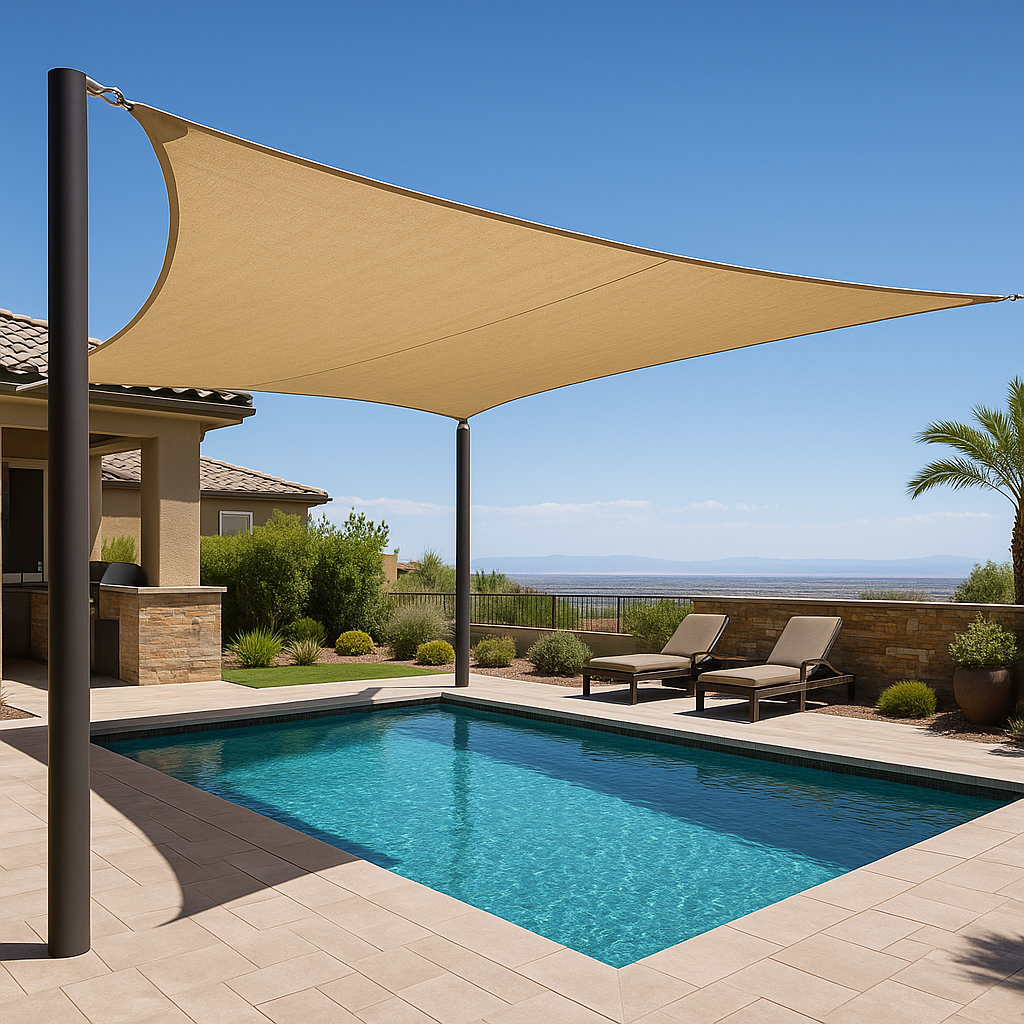Shade sails are becoming one of the most popular outdoor upgrades in Las Vegas homes and businesses. They provide much-needed protection from the desert sun while adding a modern, stylish touch to patios, pools, courtyards, and commercial spaces.

But here’s something most people don’t realize:
Not all shade sails are built to last—especially in Las Vegas.
Cutting corners on the structural setup can lead to major failures, including torn fabrics, snapped hardware, property damage, and serious safety issues. In this article, we’ll walk you through the key elements of building shade sails the right way in Las Vegas and why it’s critical to work with experienced professionals like Green Guru Landscaping.
Why You Need Commercial-Grade Quality for Las Vegas Shade Sails
Las Vegas is known for extreme heat, powerful UV rays, and—most importantly—high wind gusts. Many shade sails fail because they are built using residential-grade materials or are attached to weak anchor points like house walls or fences.
Las Vegas shade sails must be engineered to handle wind load, tension, and long-term exposure to the elements. This means:
 Using commercial-grade fabric that is UV resistant and tension-stable
Using commercial-grade fabric that is UV resistant and tension-stable Installing heavy-duty structural steel posts
Installing heavy-duty structural steel posts Securing the posts with proper concrete footings or steel base plates anchored to engineered slabs
Securing the posts with proper concrete footings or steel base plates anchored to engineered slabs
If you skip these steps, you’re risking costly failures that could have been avoided.
The Importance of Proper Concrete Footings for Shade Sails
The foundation of your shade sail setup is just as important as the fabric overhead. In most cases, concrete footings must be deep and wide enough to handle the pull and lateral force from the tensioned sail.
Shallow footings or improperly sized concrete pads are common mistakes that can lead to:
- Leaning or falling posts
- Shifting anchor points
- Premature failure during wind events
At Green Guru Landscaping, we carefully design each project to match the local wind load requirements and engineer the concrete footings accordingly. We never cut corners when it comes to safety.
Steel Posts and Base Plates: What You Should Know
Many shade sail failures in Las Vegas happen because homeowners or unlicensed contractors attach shade sails directly to houses, fascia boards, or block walls.
This is a big mistake.
Why? Because:
- Homes and walls are not designed to resist the pull of a tensioned shade sail, especially in high winds.
- Anchor bolts can rip out of walls, causing structural damage to your home or fencing.
The solution?
Freestanding steel posts installed with properly engineered concrete footings or steel base plates bolted into heavy-duty concrete pads.
When built correctly:
- Steel posts absorb and transfer the forces safely to the ground.
- The sail tension is properly supported.
- The installation can safely withstand the dynamic pressures from Las Vegas winds.
Designing a Shade Sail: Smart Tips for Las Vegas Homes and Businesses
When planning your shade sail project, keep these key points in mind:
- Always work with a professional shade sail installer in Las Vegas who understands local building codes and wind load requirements.
- Design your sail with proper slopes and angles to allow rain and debris to shed.
- Consider the sun’s angle throughout the day for maximum shade coverage.
- Never attach a shade sail to your house or perimeter walls.
- Use high-quality marine-grade hardware to prevent corrosion.
Partner with Experts Who Build Shade Sails the Right Way
At Green Guru Landscaping, we specialize in commercial-grade, properly engineered shade sail installations in Las Vegas. Our team designs every project with safety, durability, and aesthetics in mind. We use:
- Structural steel posts
- Correctly sized concrete footings or steel base plates
- UV-resistant commercial fabrics
- Professional tensioning techniques
If you’re considering adding shade to your backyard, patio, pool, or commercial space, don’t trust just anyone.
Trust the experts who know how to build it right.
 To learn more about our shade sail design and installation services, visit our Shade Sail Installation page here.
To learn more about our shade sail design and installation services, visit our Shade Sail Installation page here.


